Why all exercise is not necessarily good exercise for dentists
Imagine hiring a personal trainer, participating in a CrossFit program or simply trying a new gym machine to help improve your musculoskeletal health, only to end up in more pain than when you started! Unfortunately, I hear numerous accounts of this occurring among dentists. Most healthcare professionals do not realize that dentists are predisposed to unique muscle imbalances-certain generic exercises, that are not a problem for the general population, can throw the dentist into a vicious pain cycle.
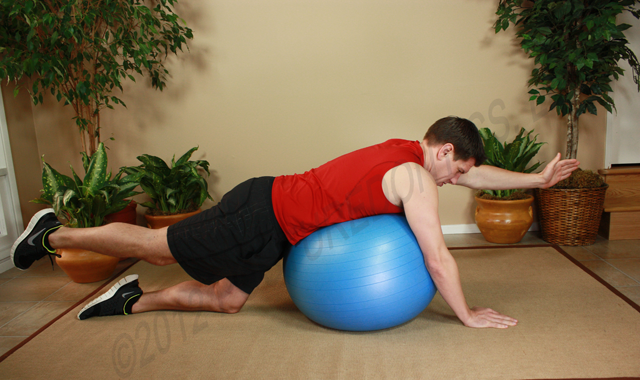
Based on the latest research, Bethany Valachi, PT, MS, CEAS explains why dentists require specific exercise due to their predisposition to unique muscle imbalances, and why certain generic exercise routines can throw dentists into the vicious pain cycle!
Imagine hiring a personal trainer, participating in a CrossFit program or simply trying a new gym machine to help improve your musculoskeletal health, only to end up in more pain than when you started! Unfortunately, I hear numerous accounts of this occurring among dentists. Most healthcare professionals do not realize that dentists are predisposed to unique muscle imbalances-certain generic exercises, that are not a problem for the general population, can throw the dentist into a vicious pain cycle. When dentists come to understand these muscle imbalances, the proverbial light bulb appears…”Ah, that’s why I always had pain after that exercise.”
Preventing work-related pain or disability among dental professionals is rightfully a growing concern, as up to 81 percent of dentists and hygienists experience work-related pain in a 12-month period.1-4 A natural tendency is to ‘wait for the painful episode’ before action is taken. Unfortunately, by this time, irreversible structural damage may have occurred.5 Team members must therefore become advocates for their own musculoskeletal health and implement wise prevention strategies prior to the ‘painful episode’. Developing balanced musculoskeletal health through proper strengthening exercise can help dentists avoid work-related pain, injury or early retirement.
Pain and unbalanced muscles
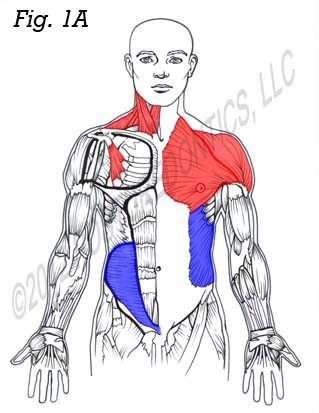
In order to perform the precision tasks of dentistry, the arms must have a stable base from which to operate. For example, the delivery of dental care requires excellent endurance of the shoulder girdle stabilizing muscles (especially the middle and lower trapezius muscles) for safe shoulder movement and working posture (Fig. 1B-in blue). These shoulder stabilizing muscles tend to fatigue quickly with forward head, rounded upper back and elevated arm postures-all commonly seen among dentists.6 When these muscles fatigue, other muscles compensate and become overworked, tight and painfully ischemic (Fig 1A & 1B-in red).
This muscle imbalance may result in ‘tension neck syndrome’, a frequently diagnosed disorder among dentists. Symptoms include pain, tenderness and stiffness in the neck and shoulder musculature, commonly with pain that radiates between the shoulder blades or up into the occiput. Two contributing factors to tension neck syndrome in dentistry are forward head and elevated arm postures.
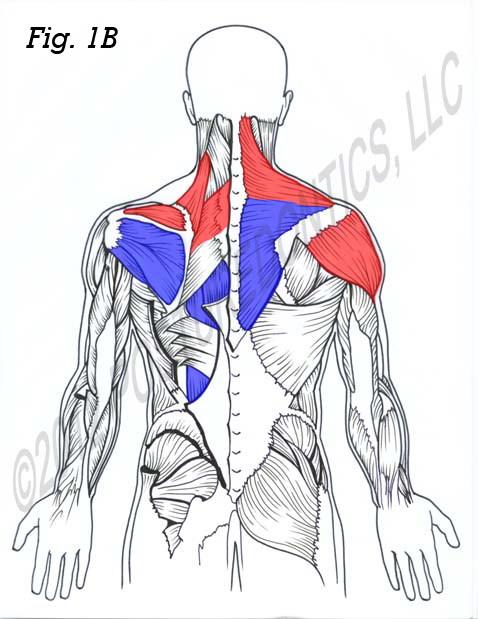
Another common imbalance among dentists is in the shoulder, caused by over-strengthening the deltoid and supraspinatus muscles. These muscles already tend to be strong in dentists due to frequent posturing with the arms lifted away from the sides of the body. This imbalance can cause improper movement at the shoulder joint, with painful impingement of the rotator cuff tendon and a myriad of other shoulder dysfunctions.
More from Bethany Valachi: Dentistry shouldn't be a pain in the neck: Strategies to avoid discomfort in the operatory
The muscle imbalance that tends to develop between the abdominal and low back muscles is especially problematic in seated dentistry. Leaning toward a patient repeatedly with rounded back posture can cause strain and overexertion in the superficial low back extensors, while the deep stabilizing abdominal muscles (transverse and oblique abdominals) tend to become weaker.
Developing an effective exercise regimen
In a society that bombards us with exercise options, from Ab-blasters to Bun-busters, it’s hard to imagine that strengthening your muscles could be anything but beneficial. Yet, because of the muscle imbalances described above, all exercise is not necessarily good exercise for dentists.
An effective exercise regimen for dentists will target specific shoulder girdle, trunk and back stabilizing muscles, without engaging the muscles that are prone to tightness and ischemia (deltoids, pectoralis, upper trapezius, scalenes and many more). This requires expert knowledge of biomechanics and kinesiology. In addition, specific muscles that are prone to tightness and ischemia must be targeted with stretching exercise and avoid over-strengthening.
Studies show that strength-training or heavy weight training is NOT protective against pain syndromes caused by prolonged, static postures, as in dentistry.7 However, research shows that a method called muscular endurance training can help dental professionals reduce neck, shoulder and back work-related pain.7-10 Developing the endurance of postural muscles of the trunk and shoulder girdle is key to preventing pain and injuries in dentistry.
Exercise wisely

Since the postural stabilizing muscles (Fig 1-in blue) perform low-level static contractions for prolonged periods in the operatory, they must be trained for endurance in a similar manner.
- Use light resistance and high repetitions (15-20 reps) when training these muscles. Usually an elastic exercise band is sufficient for the shoulder muscles, while gravity-resisted exercise on the floor or an exercise ball is good for the trunk muscles.
- Perform strengthening exercises three times a week, always allowing one day in between sessions.
- Target specific tight, ischemic muscles with regular chairside stretching. Stretching should be performed daily, and is especially important for male dentists who are more prone to injuries due to poor flexibility.
- Strengthening exercises should only be performed when there is no musculoskeletal pain in the area and full range of motion is present.
- Always discontinue exercise if you experience pain.
- It is a good idea to seek professional guidance from a physical therapist when beginning any new exercise regimen and to ensure safety and good technique.
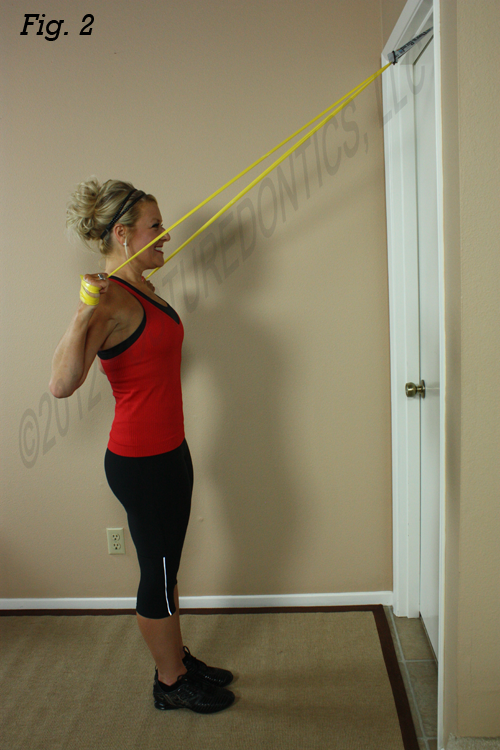
Today’s dental staff meets the ball and band
All of the exercises needed to correct dental professionals’ muscle imbalances can be achieved with a simple Swiss ball and elastic exercise band. The Swiss ball has been an accepted therapy tool used by physical therapists worldwide for more than 30 years, and is utilized in many exercises that research shows help manage and prevent back pain.11 Studies show that exercises performed on the Swiss ball elicit more muscle activity than when performed on a stable surface.12 The ball provides a safe and effective method for improving spinal health via endurance strengthening of the deep postural muscles, increasing coordination and balance and improving flexibility of the spine. The elastic exercise band enables exercise that corrects shoulder girdle and upper body imbalances. The exercise ball and band are inexpensive and easy ways to perform effective workouts in the comfort of your own home, which, in turn, leads to greater adherence to your exercise program.
Following are four exercises from the “Smart Moves for Dental Professionals On the Ball” Home Exercise DVD:
Trending article: 5 ergonomic products you should know
Downward squeeze (Fig. 2)
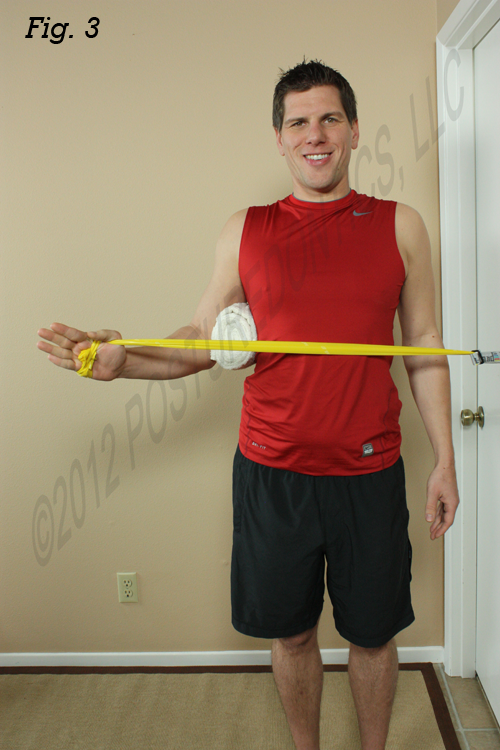
Helps prevent neck pain by correcting an upper/lower trapezius imbalance that is common in dental professionals. Position door anchor above head level. Loosely wrap band around both hands and position arms at sides, fingers pointing upward. Make sure the downward angle of the theraband is about 45 degrees. Maintain optimal head posture (ear-over-shoulder, chin tucked) and pull navel to spine, holding this contraction throughout the exercise to avoid arching your low back. Roll shoulders back and down, squeezing shoulder blades downward and together. Pause briefly and slowly return. Repeat 10-20 times. If you have discomfort, decrease the resistance of the exercise band.
More on ergonomics: The top 4 unconventional ergonomic tips
External rotation (Fig. 3)
This exercise helps correct a painful muscle imbalance in the rotator cuff that frequently occurs among dentists due to elevated arm postures. (Many trainers unwisely recommend the opposite exercise, Internal Rotation, without realizing that most dental professionals already have tight internal rotators, and this can worsen their pain!) With the door anchor at elbow height, stand at a right angle to the door holding a small pillow or rolled towel between your elbow and your body. Squeeze shoulder blades together then slowly rotate the arm outward, then return. Keep the elbow pressed firmly against your side throughout the exercise. You should be able to perform 10-20 repetitions easily. Repeat with other arm.
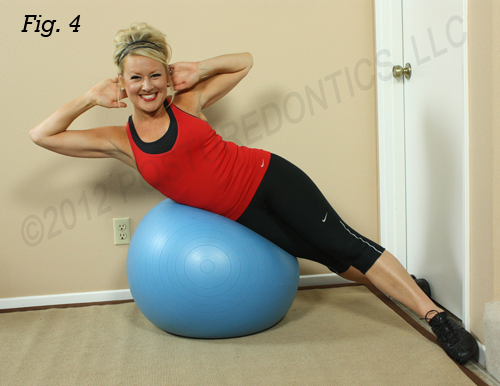
Side lift (Fig. 4) 13
Research supports endurance training of the quadratus lumborum in preventing low back pain.9 Place the ball under one side and position your top foot in front of bottom foot against the wall so you are securely balanced. Interlock your hands behind head, tuck you chin, pull navel to spine and slowly lower the body over the ball and raise to straight position while avoiding any twisting.
Repeat 10 times on each side.
Pointer dog (Fig. 5)
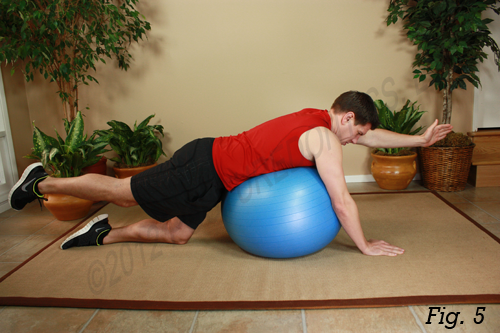
Studies show that individuals who effectively utilize & train their natural ‘back belt’-the tranverse abdominal muscles-have less low back pain.14-15 This exercise targets 4 essential stabilizers in one exercise! Position yourself on hands and knees over the ball with your chin slightly tucked. Contract the lower abdominals and pull your navel up toward your spine. Hold this contraction throughout the exercise. Make sure your back is flat and hips are level. Slowly lift the right arm, thumb pointing up, hold, then lower it. Slowly lift the other arm, hold, then lower. Repeat for the right and left legs. Continue to perform five lifts on each arm and leg.
Advanced version: Lift the right arm and left leg together and hold. Make sure you are still contracting your lower abdominals! Repeat for opposite arm/leg.
The “Smart Moves for Dental Professionals On The Ball” Home Exercise DVD, was created specifically for dental professionals to address & correct the painful muscle imbalances to which they are uniquely predisposed. Based on the latest research on dental ergonomics, neck pain, back pain and biomechanics, the DVD includes three complete exercise routines (24 exercises) and also describes which exercises, routines and gym machines can worsen dentists’ health. Educational narrative throughout the DVD helps the operator apply concepts to his or her everyday practice. The home exercise DVD kit contains a Swiss ball, two elastic exercise bands, Theraband door anchor, DVD, instruction booklet, and cue card. (The DVD kit is available at www.posturedontics.com. Enter Discount Code OTB2016 upon checkout to receive Dental Products Report special discount.)
Conclusion
Embarking upon an exercise program requires prudence and discretion, considering team members’ predisposition to certain muscle imbalances. Selecting improper exercises can lead to imbalance, ischemia, nerve impingement, and other pain syndromes. Developing balanced musculoskeletal health with a well-designed exercise program can help dentists prevent work-related pain, avoid injuries, extend their careers and improve their quality of life.
To receive the free article: “Exercises that can Worsen the health of Dental Professionals”, please e-mail info@posturedontics.com.
References
1) Shugars D, Fishburne C, et al. Musculoskeletal pain among general dentists. General Dentistry 1987; July-Aug:272-276.
2) Auguston T, Morken T. Musculoskeletal problems among dental health personnel. A survey of the public dental health services in Hordaland. Tdsskr Nor Laegeforen. 1996; 116:2776-80.
3) Finsen L, Christensen H, Bakke M. Musculoskeletal disorders among dentists and variation in dental work. Applied Ergonomics 1997; 29:2:119-125.
4) Chowanadisai S, Kukiattrakoon B, et al. Occupational health problems of dentists in Southern Thailand. International Dental Journal 2000; 50:36-40.
5) Valachi B, Valachi K. Mechanisms leading to musculoskeletal disorders in dentistry. Journal of the American Dental Association 2003;10:1344-50.
6) Novak C, Mackinnon S, Repetitive use and static postures. J Hand Thera 10(2):151-9, April –June 1997.
7) Lehto TU, Helnius HY, Alaranta HT. Musculoskeletal symptoms of dentists assessed by a multidisciplinary approach. Community dentistry and oral epidemiology 1991; 19:38-44.
8) O’Sullivan PB, Mitchell t, Bulich P, Holte J. The relationship between posture and back muscle endurance in industrial workers with flexion-related low back pain. Manual Therapy 2005 June 10
9) McGill S. Low Back Disorders: Evidence-Based Prevention and Rehabilitation. Human Kinetics, Champaign, IL. 2002
10) Rundcrantz B, Johnsson B, Moritz U. Occupational cervico-brachial disorders among dentists. Swedish Dental Journal 1991; 15:105-115.
11) Marshall PW, Murphy BA. Evaluation of functional and neuromuscular changes after exercise rehabilitation for low back pain using a Swiss ball: a pilot study. J Manipulative Physiol Ther. 2006; 29(7):550-60.
12) Duncan M. Muscle activity of the upper and lower rectus abdominis during exercises performed on and off a Swiss ball. J Bodyw Mov Ther 2009;13(4): 364-7.
13) Valachi B. Practice Dentistry Pain-Free: Evidence-based Strategies to Prevent Pain & Extend Your Career. Posturedontics press, Portland, OR. 2008.
14) Sahrmann S. Diagnosis and Treatment of Movement Impairment Syndromes. St. Louis: Mosby; 2002:196.
15) Richardson C, Jull G, Richardson B. A dysfunction of the deep abdominal muscles exists in low back pain patients. In Proceedings World Confederation of Physical Therapy, Washington 1995:932.
Oral Health Pavilion at HLTH 2024 Highlighted Links Between Dental and General Health
November 4th 2024At HLTH 2024, CareQuest, Colgate-Palmolive, Henry Schein, and PDS Health launched an Oral Health Pavilion to showcase how integrating oral and general health can improve patient outcomes and reduce costs.
Episode 31: Dentsply Sirona Implant Announcements
September 30th 2021DPR’s Editorial Director Noah Levine sat down with Gene Dorff, Dentsply Sirona’s group vice president of implants and Dr. Dan Butterman to review several big announcements the company made in the arena of implants during Dentsply Sirona World 2021 in Las Vegas.
